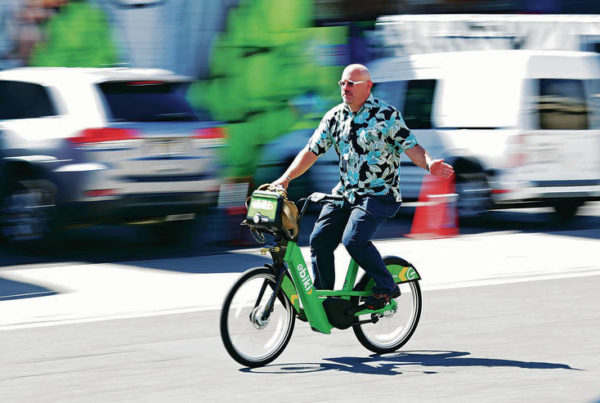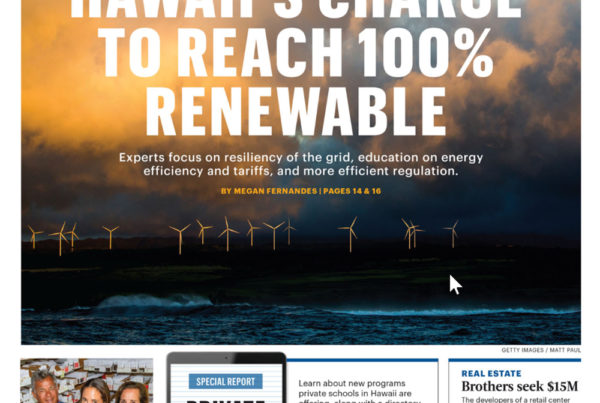Hawaii Business
April 9, 2019
GINA GELBER
 Q: What’s ahead for the construction industry this year?
Q: What’s ahead for the construction industry this year?
Kaneshiro: We’ve been in an upswing since 2011 and construction is cyclical, so there is an expectation of a downside at some point. There is stock market volatility. There is instability in the financial markets, which could impact projects if people lose funding. But from our perspective, the first six months of 2019 is business as normal, and we usually don’t forecast projects beyond six months. The expectation is that by third or fourth quarter there may be a slowing of projects in the industry, but we will see.
Q: Severe weather events are on the rise. How can architecture help communities cope?
Kaneshiro: As a multidisciplinary firm, not only in architecture, but also in civil engineering and planning, we think deeply about resiliency. The city and the state are ratcheting up how we plan for the future. We could get a requirement to plan for the 100-year flood, but what does that mean (from a cost perspective)? The challenge is understanding the dollar value of resiliency.
I look at Japan, where they know they are going to get hit by a typhoon every year. For them, a typhoon is almost like a regular storm because they invested in resilience many years ago. The cost to rebuild and to construct projects in Japan is higher than in the U.S. because everything has to be built to withstand severe weather. I was in Japan during a Category 4 typhoon. My hotel was fine. Disneyland Tokyo was open. It was business as usual, for the most part.
Q: It can be overwhelming. Where do we get started?
Kaneshiro: At the government level, we need to look at our entire infrastructure resiliency for the future knowing that severe weather is the new normal. What if the flooding that happened in Hanalei in 2018 took place in Waikiki? We have to bite the bullet as a society and pay for the infrastructure. What happens when systems can’t handle the stormwater? Or when the sewer backs up from rising water levels? This goes beyond just the buildings.
Q: What are some defensive moves that are less daunting?
Kaneshiro: Landscaping can help buffer against some storms because it absorbs water. But landscaping is the first thing that gets cut off because people just see it as a way to make a location beautiful, without realizing it is also functional.
One great example is in the Haleiwa town redevelopment, which incorporated depressions to drain stormwater.
It looks more like overgrown weed, but it is intentional landscaping. If you pave over that landscaping, you remove a powerful barrier against flooding.
“The challenge is understanding the dollar value of resiliency.” – Charles Kaneshiro, President & COO, G70
Q: Is environmental design becoming more mainstream?
Kaneshiro: Yes. So whether you are certified as LEED or not, we view projects in a way that incorporates energy savings and respect for the environment.
We are heavily into biophilic design, where we integrate the building and environment so they become one. This is not foreign to Hawaii when we think about the things that Vladimir Ossipoff was doing with his houses or the Pacific Club. Those are naturally ventilated so they don’t get hot. They can be net zero.
Another example is the new kindergarten and first grade at Iolani, where we brought the garden into the classrooms. There are two kindergarten classrooms and between them is this space where they can grow vegetables.
Meanwhile, the first-grade classrooms will have a treehouse between the two classrooms. We gave the school the concept and the students have designed it and are fabricating it out of real wood, which is great because how often do you get to touch real wood nowadays?
Q: What projects excite you now?
Kaneshiro: All of them. Kihei High School is exciting. It is groundbreaking because it will be the first net zero (carbon) campus and it is a public school. It shows the willingness of the state to be open and progressive. I hope it is part of a trend because we are doing it at no additional cost. We had to use our own innovation and design to make that happen. It shows it can be done without spending a lot of extra dollars. The secret is you have to bring architects in early. They have to be at the table at the conceptual stage.
Q: What should we do about the affordable housing crisis in the state?
Kaneshiro: I’ve talked to a lot of people about this and the economics are tough to make happen in Hawaii for many factors, including the cost of land, the cost of construction, the permitting process, etc.
I don’t have a specific solution, but what I would say is that bringing architects in early – before entitlement and planning – is a good idea. It makes sense when you are strategically thinking of things like: How can we make the financing work and how do we use creativity to overcome certain barriers?
I just had a conversation with a client who is thinking about a couple of projects and I was asked for my opinion on elements like marketing and financing.
We talked through it all and, as a result of our conversation, he decided to tweak some things to make the project more competitive. We’re not even designing this thing, but we are bringing up important points they hadn’t thought about. Having architects at the table asking crazy questions and using creativity is a useful tool in helping us find ways to contain this important issue.
This interview has been edited for clarity and conciseness.







